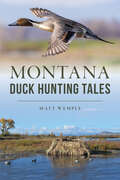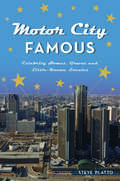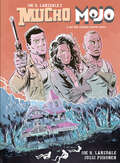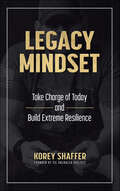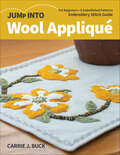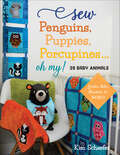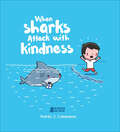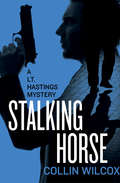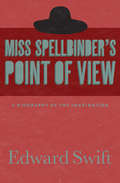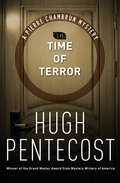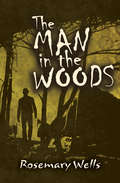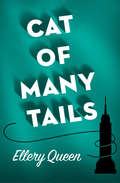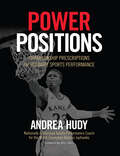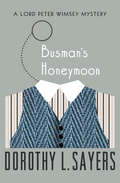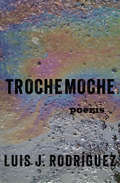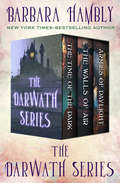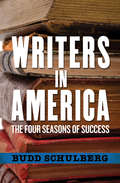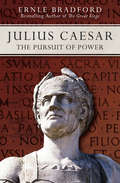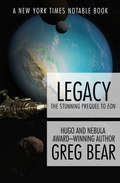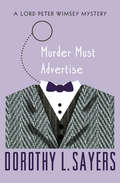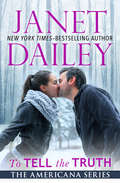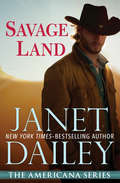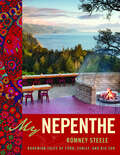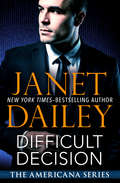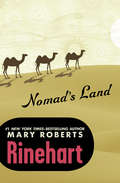- Table View
- List View
Montana Duck Hunting Tales (Sports)
by Matt WempleDucks across the Big Sky To hunt ducks in Montana--where the land breathes history--is to experience extremes in geography, weather and wildlife. The breadth of mountains and prairie is unlike anywhere else in the Lower 48. Both the Central and Pacific flyways span the state's iconic wetlands, rivers and lakes. Hunting opportunities abound thanks to the state's wildlife conservation legacy on public and private lands. Hunters walk in the footsteps of plains Indians, Lewis and Clark and mountain men while looking for a spot to pitch decoys. Embark on an epic and distinct Big Sky journey with author and hunter Matt Wemple, where a moose or grizzly bear could stroll through the decoys at any time.
Motor City Famous: Celebrity Homes, Graves and Little-Known Locales (History & Guide)
by Steve PlattoMost know Detroit as the hometown of Motown legends like Diana Ross, Marvin Gaye and Stevie Wonder. And they're all here! But beyond the well-known list of famous Detroiters awaits a veritable who's who of pop culture, sports, TV, movies and more. Christie Brinkley, Robin Williams, Sonny Bono, Lucille Ball, Charles Lindbergh, Robert Wagner, Lizzo, Tom Selleck, Ty Cobb, the creator of Gumby, the guy who portrayed Jaws in the James Bond films, and many more. Compiling over 100 names and places, author Steve Platto leads a celebrity tour of the Motor City that readers can take with them on their own travels or explore from the comfort of home.
Mucho Mojo: A Hap and Leonard Graphic Novel
by Joe R. Lansdale Jussi PiironenMucho Mojo is the basis for the second season of the new Sundance TV series Hap and Leonard and has been adapted into a full color graphic novel by Finnish illustrator Jussi Piironen.Hap and Leonard return in this incredible, mad-dash thriller, loaded with crack addicts, a serial killer, and a body count.Leonard is still nursing the injuries he sustained in the duo's last wild undertaking when he learns that his Uncle Chester has passed. Hap is of course going to be there for his best friend, and when the two are cleaning up Uncle Chester's dilapidated house, they uncover a dark little secret beneath the house's rotting floor boards— a small skeleton buried in a trunk. Hap wants to call the police. Leonard, being a black man in east Texas, persuades him this is not a good idea, and together they set out to clear Chester's name on their own. The only things standing in their way is a houseful of felons, a vicious killer, and possibly themselves.
Legacy Mindset: Take Charge of Today and Build Extreme Resilience
by Korey ShafferWe're all broken in some way-but "broken" is not forever. In fact, it's just part of the story of how we build our legacies. Entrepreneur and US Marine Korey Shaffer's road through life was tougher than most. After returning from a harrowing tour of duty in Afghanistan, and still aching from his troubled childhood and adolescence, Shaffer felt his chance to leave something of value to the world might have passed. But even in despair, he knew that many did not return home at all, or returned more broken than he was. Determined that the wounded and fallen not be abandoned or forgotten, Shaffer founded the Til Valhalla Project, an organization devoted to honoring the fallen and preventing veteran suicides. Til Valhalla unexpectedly proved to be Shaffer's salvation as well. Sharing intimate details from his square-peg childhood, reckless adolescence, brotherhood-seeking teen years, and traumatic experiences in combat and back home, Shaffer demonstrates that society doesn't dictate who we are or will be-that is up to us. The path to who we can become lies through careful, daily exercise of will, repetition, and affirmation. Shaffer is convinced that the discipline he drew from this struggle can be of use to others. What it takes to overcome the broken state, Shaffer contends, is a willingness to face pain head-on and use adversity as rocket fuel to regain purpose and create resilience. In Legacy Mindset: Take Charge of Today and Build Extreme Resilience, Shaffer lays out the sinews and bones of the daily discipline that allowed him to repair what was broken and build upon it. He challenges us to: -Evaluate whether our pain is constructive or destructive -Reassess what things in life we assign value to -Radically change our daily habits by practicing micro-disciplines -Trust our intuition when it is telling us to speak up -Commit to excellence in everything we do-even when no one is watching
Jump Into Wool Appliqué: For Beginners; 6 Embellished Patterns; Embroidery Stitch Guide
by Carrie J. BuckLearn the art of wool appliqué Beginners rejoice—getting started with wool appliqué has never been easier! This project-based introductory guide will give you everything you need to know to explore and enjoy a fun, hands-on fiber art. Stitch six cute flora-and-fauna-themed projects onto sewing accessories, bags, wallhangings, pillows, and more. Each project includes an embroidery embellishment for extra inspiration. While this book is ideal for beginners, the adorable designs are still perfect and enjoyable for all sewists! Wool appliqué beginners delve into 6 versatile projects with step-by-step instructions Includes comprehensive information on tools needed plus endless tips and tricks The second book in our “Jump into” series—explore a fun, new, and relaxing fiber art technique!
Sew Penguins, Puppies, Porcupines . . . Oh My!: Baby Animals; Quilts, Bibs, Blankies & More!
by Kim SchaeferSew sweet baby-shower gifts featuring baby animals! Be the star of the baby shower! Appliqué adorable baby animals onto gifts that will be snuggled now, and treasured for years to come. Fans flock to Kim Schaefer’s best-selling designs, and 39 new nursery-themed baby animals are sure to roar, tweet, and moo their way into your hearts. Choose your animal adventure, with zoo and farm favorites, underwater creatures, woodland denizens, or animals of the northwest! You can make a darling baby quilt or create an entire layette! Embellish store-bought bibs, burp cloths, onesies, diaper covers, and diaper stackers with these too-cute designs for a personalized gift in no time. Other sweet and simple projects include crib quilts, security blankies, a bench bolster, and two wallhangings. Oh baby! Appliqué bestselling author Kim Schaefer’s nursery animals, from woodland creatures to zoo, farm, northwoods, and underwater friends Sew 39 cheery animal motifs in darling 6-inch blocks for adorable crib quilts, wallhangings, and pillows Personalize readymade onesies, bibs, burp cloths, diaper covers, or diaper stackers for quick and thoughtful gifts
When Sharks Attack With Kindness
by Andrés J. ColmenaresThis hardcover collection features the cute, uplifting and ingenious aquatic cartoons of Andrés Colmenares, the creator of Wawawiwa Comics, followed by millions of fans around the globe. While sharks are one of the ocean&’s deadliest predators, these sharks can smell insecurity, doubt, and gloom, and are quick to strike — with kindness, cuteness, and positivity!When Sharks Attack With Kindness includes a QR code linking to a special instrumental soundtrack for audiences to enjoy while reading the book.
Stalking Horse (The Lt. Hastings Mysteries #10)
by Collin WilcoxA senator&’s life is in danger—and anyone in San Francisco could be a killerSenate majority leader Donald Ryan is a kingmaker, with the power to make or break presidencies, and the ability to reshape the country with a flick of his pen. He is also a very sick man, recovering from a heart attack that must be kept secret at all costs. But when a series of death threats jeopardizes his planned return to public life, the FBI calls in San Francisco police lieutenant Frank Hastings to find the would-be assassin. He has one week until the senator&’s next public appearance—and hundreds of thousands of possible suspects.Because Ryan&’s recent heart attack is considered a state secret, Hastings is forced to withhold crucial details from his fellow detectives. Any degree of stress could stop the senator&’s fragile heart, which means that even if a bullet misses, the sound of the gunshot might be enough to kill him. To save the lawmaker, Hastings may have to put himself in the line of fire.
Miss Spellbinder's Point of View: A Biography of the Imagination
by Edward SwiftIn this &“delightful and bizarre&” novel, Clarissa Spellbinder spins the yarn of her truly unbelievable—and completely unverified—life (The Boston Globe). Miss Clarissa Spellbinder has lived a truly astonishing life . . . or so she tells us. Her father was the intrepid adventurer Lord Andrew Spellbinder and her mother, the fiery Latin songbird Amelita de la Luna, who traveled the world and escaped almost certain death on numerous occasions. Miss Spellbinder relates their spectacular exploits to the patrons of the Back Door Bar That Once Faced the Sea on the fantastical island of Moly—though her listeners seem far more interested in hearing about the misadventures (of the sexual variety, mainly) of Clarissa&’s enormous neighbor, the former carnival circuit star Fat Satsuma Johnson, a.k.a. the Black Queen of the Atchafalaya, a.k.a. the pie-eating queen of southern Louisiana. Miss Spellbinder, of course, is more than happy to oblige, since all her stories serve as ammunition in her ongoing battle against &“the disease of the literal minded.&” What matters most, she tells us, is a unique point of view, for without one, &“you have no pinnacle on which to stand and express yourself.&” Edward Swift (Splendora) indulges readers with a novel unlike anything they have read before, an epic voyage through the outrageous history, real and imagined, of Miss Clarissa Spellbinder. It is a journey that may entail a certain suspension of disbelief—but afterward, the world will look very different.
Time of Terror (The Pierre Chambrun Mysteries #11)
by Hugh PentecostWhen an army of freedom fighters takes the entire Beaumont hostage, Chambrun contemplates a commando attackPierre Chambrun, the elegant manager of the Beaumont Hotel, gets the call just after breakfast: The fifteenth floor has been seized. Armed with guns, grenades, and plastic explosives, a gang of guerrillas has taken the daughters of the British ambassador hostage, and they are ready to kill to make themselves heard. For these men are combatants, veterans of the war in Vietnam who have come to demand justice for South Vietnamese political prisoners, as well as the release of American soldiers accused of massacring civilians and court martials for the generals who started the war in the first place. Their demands are impossible, but their firepower cannot be ignored. As Chambrun scrambles to rescue his hotel, he does everything he can to stall the madmen, including sending them all the room service they can eat. But in just a few days, trigger fingers will start to itch, and the world-famous Beaumont Hotel may be blown sky high.
The Man in the Woods
by Rosemary WellsWho is the man in the woods—and can Helen catch him before it&’s too late?Helen&’s first day at New Bedford Regional High School is off to a hectic start. Her locker combination doesn&’t work, she&’s late to all her classes, and she doesn&’t know a single person. But she doesn&’t need friends to figure out the unofficial rules: Cheerleaders simply don&’t associate with frizzy-haired new girls who look too young and draw political cartoons. And when Mr. Brzostoski confiscates one her drawings during class, Helen thinks her first day can&’t get any worse, but her luck changes. Instead, Mr. Bro invites Helen to join the school paper, where she meets Pinky Levy—who helps her get her locker open. But after school, fate throws Helen and Pinky together again when they both witness a car wreck. Someone threw a stone at the car window and caused the crash, and Helen is sure she saw a man in the woods nearby. When the police arrest one of her fellow students, she knows they have the wrong person—but Pinky is the only one who believes her. Will she be able to find the true identity of the man into the woods before it&’s too late? This ebook features an illustrated biography of Rosemary Wells including rare images from the author&’s collection.
Cat of Many Tails
by Ellery QueenThe famous sleuth comes out of retirement to help his father hunt down a New York City serial killer: &“Marvelous . . . one of his best&” (Classic Mysteries). In the dog days of August, it is no surprise to see New Yorkers perspire. But this summer, a killer called the Cat gives the city a new reason to sweat. He selects his victims seemingly at random and strangles them, then escapes without leaving a clue. As the death toll climbs, and the press whips the public into horrified frenzy, Gotham teeters on the edge of anarchy. Ellery Queen, the brilliant amateur sleuth, has gone into retirement when the Cat begins to kill. As his father, a seasoned homicide detective, leads the investigation into the murder, Ellery tries to avoid getting involved. But as the body count rises, he can no longer resist the urge to hunt. The Queens are known for their curiosity—and everyone knows how curiosity can affect a cat.
Power Positions: Championship Prescriptions for Ultimate Sports Performance
by Andrea HudyAndrea Hudy has trained numerous NCAA national championship teams, elite athletes, and National Basketball Association players. The Wall Street Journal calls her &“The Kansas Jayhawks&’ Secret Weapon.&” In Power Positions, Hudy shares her specific training prescriptions designed to maximize sports performance. &“The Hudy Movement&” provides a unique way to look at movement and training that is grounded in science to build a better athlete and a better person. Author Andrea Hudy has worked with the best researchers in the field to design a training method that is research-based and integrates leading technology to drive proven results for athletes.
Busman's Honeymoon: A Lord Peter Wimsey Mystery With Harriet Vane (The Lord Peter Wimsey Mysteries #11)
by Dorothy L. SayersIn this installment of the &“literate and delightful&” Lord Peter Wimsey Mysteries, Harriet Vane&’s honeymoon with the dapper British detective is marred by murder (Chicago Tribune). It took several near-death experiences for Lord Peter Wimsey to convince Harriet Vane to be his wife, but she has finally relented. When the dapper detective marries Britain&’s most popular mystery author—just a few short years after rescuing her from the hangman&’s noose—the press could not be more excited. But Lord Peter and his bride have no interest in spending their wedding night surrounded by reporters. They sneak out of their own reception to begin their honeymoon early, out of sight of the world. Unfortunately, for some couples, calamity is inescapable. On their 1st morning together, the newlyweds discover the house&’s caretaker bludgeoned to death in the manor&’s basement. If they thought finding a few minutes alone was difficult, they&’re up against even steeper odds. In a house full of suspects, identifying the killer won&’t be easy. Busman&’s Honeymoon is the 13th book in the Lord Peter Wimsey Mysteries, but you may enjoy the series by reading the books in any order. This ebook features an illustrated biography of Dorothy L. Sayers including rare images from the Marion E. Wade Center at Wheaton College.
Trochemoche: Poems
by Luis J. RodríguezPoems of the barrio and of the Americas beyond Spanish for &“helter-skelter,&” Trochemoche begins by conjuring life in the barrio, whether in a slum in a Texas border town or in L.A., the vast, hectic, desperate California metropolis where Luis J. Rodríguez grew up. For Rodríguez, only art offered deliverance from the despair of gang violence and poverty, and these poems stand as prayers for transcendence, recorded long after Rodríguez escaped his violent past and began to explore the wider world. Here Rodríguez offers not only songs of the American dream, but a dream of the Americas, a place that invites a pell-mell, sometimes violent, collision of cultures, human impulses, and natural forces. This ebook features an illustrated biography of Luis J. Rodríguez including rare images from the author&’s personal collection.
The Darwath Series: The Time of the Dark, The Walls of Air, and The Armies of Daylight (The Darwath Series #Bk. 1)
by Barbara HamblyFrom a New York Times–bestselling author, three novels of a modern-day medievalist beset by murder and magic—&“A fabulously talented writer&” (Charlaine Harris). As a student of medieval history, Gil Patterson is a woman familiar with dark stories. She knows the Crusades, the Black Death, and the other horrors of the Middle Ages all too well, but it is another kind of atrocity that has begun to haunt her dreams. She sees forces of evil assaulting a beleaguered kingdom, whose kind people are on the brink of annihilation, and awakes each morning in a cold sweat. In The Time of the Dark, Gil dismisses the dreams until a wizard appears in her apartment. He has crossed into her dimension, passing through the fraying fabric of the universe, to ask her help. For mankind to survive he must protect an infant prince, whom he plans to hide in Gil's world. She is about to get much closer to evil than she ever imagined. In The Walls of Air and The Armies of Daylight, Gil and Rudy know the world is no longer safe and there is nowhere to hide from the Dark. Since the Dark Ones returned, the world has been laid to waste. The land&’s wizards have been slaughtered, its cities destroyed, and its people scattered in terror. Few have witnessed more of the destruction than Gil and Rudy, and both of them will need all their strength to survive this final challenge. Ingold, the master wizard, has devised a spell to hide the user from the deathly stare of the Dark, and he intends to use it to strike at their very heart. Finally, Gil, Rudy, and the rest of mankind&’s survivors will take the offensive, bringing an end to this terrible war, for better or for worse.
Writers in America: The Four Seasons of Success
by Budd SchulbergStories of twentieth-century American literary giants, by the man who was their friend, peer, and confidant When he was introduced to F. Scott Fitzgerald as a potential partner on a screenplay, novelist and scriptwriter Budd Schulberg was surprised the author was still alive. In Schulberg&’s view, the pressures of success and the public&’s merciless judgment had destroyed Fitzgerald&’s talent early in his career—a situation that is arguably typical for many of America&’s great literary geniuses. In Writers in America, Schulberg shares memories and insights from his relationships with authors such as Fitzgerald, John Steinbeck, Nathaneal West, and Sinclair Lewis, as well as brilliant writers who never attained the success and recognition they deserved, such as Thomas Heggen. This ebook features an illustrated biography of Budd Schulberg including rare images and never-before-seen documents from the author&’s estate.
Julius Caesar: The Pursuit of Power
by Ernle BradfordThe epic life story of the Roman statesman, military commander, and dictator, from the bestselling author of Thermopylae. Born to Roman aristocracy in 100 BC, Julius Caesar became one of the most powerful men in history. He was a military genius, a fierce politician, and a brilliant writer and orator. When he formed an alliance with Pompey and Crassus, the triumvirate of officials took control of the Roman Republic. But Caesar&’s quest for power was only beginning. As proconsul, he went to war against the Gallic tribes of the north, extending Roman territory into Gaul, Belgium, Germany, and Britain. When the Gallic Wars ended, the Roman senate called on Caesar to return to private life. But rather than relinquish his title, Caesar led his legion into a civil war that would spell the end of the Roman Republic and the beginning of the Roman Empire. In this thrilling and thoroughly researched biography, Ernle Bradford cuts through the legends in order to present a truthful and nuanced portrait of a man whose pursuit of power knew no bounds.
Legacy: A Novel (Eon #1)
by Greg BearA New York Times Notable Book: &“Hard science and human interest intersect ingeniously in this prequel to [Greg] Bear&’s Eon and Eternity&” (Publishers Weekly). The Way is a tunnel to the multiverse, infinite possible realities throughout the universe. From its entranceway in Axis City, the space station at the center of the asteroid-starship Thistledown, one may travel to any world and any time. Lamarckia is a world very much like Earth, but populated by shapeshifting biological forms. More than four thousand colonists have illegally used the Way to settle there, and the ruling gatekeepers fear that the interaction between humans and aliens could prove devastating to the future of both species. Now, Olmy Ap Sennon has been sent to Lamarckia to spy on the colonists and investigate their effect on their new home. As he witnesses their struggle to survive their unforgiving environment—and each other—Olmy experiences all of the joy and heartache that comes from a life worth living, in &“a stunning SF novel that extrapolates a scientifically complex future from the basic stuff of human nature&” (Publishers Weekly, starred review).
Murder Must Advertise: A Lord Peter Wimsey Mystery (The Lord Peter Wimsey Mysteries #8)
by Dorothy L. SayersLord Peter Wimsey goes undercover at an ad agency to find out who pitched a copywriter down a flight of stairs—&“Delightful reading&” (The New York Times). The iron staircase at Pym&’s Publicity is a deathtrap, and no one in the advertising agency is surprised when Victor Dean tumbles down it, cracking his skull along the way. Dean&’s replacement arrives just a few days later—a green copywriter named Death Bredon. Though he displays a surprising talent for the business of selling margarine, alarm clocks, and nerve tonics, Bredon is not really there to write copy. In fact, he is really Lord Peter Wimsey, and he has come to Pym&’s in search of the man who pushed Dean. As he tries to navigate the cutthroat world of London advertising, Lord Peter uncovers a mystery that touches on catapults, cocaine, and cricket. But how does one uncover a murderer in a business where it pays to have no soul? Murder Must Advertise is the 10th book in the Lord Peter Wimsey Mysteries, but you may enjoy the series by reading the books in any order. This ebook features an illustrated biography of Dorothy L. Sayers including rare images from the Marion E. Wade Center at Wheaton College.
To Tell the Truth: Oregon (The Americana Series #37)
by Janet DaileyAn Oregon ski trip leads to an avalanche of desire in the New York Times–bestselling author&’s series that sets each novel in a different state. &“Lucky at cards, unlucky in love.&” Tell&’s words as they left the casino brought the haunted look back into Andrea&’s eyes. The skiing holiday in Squaw Valley was all she&’d hoped for. And she had totally ignored the warning voices that cautioned her to stay away from Tell Stafford. A lot of girls indulged in harmless flirtations. Why shouldn&’t she? But Andrea and Tell had fallen deeply in love, and now it was too late. Andra knew that if she revealed her terrible secret, everything would change….
Savage Land: Texas (The Americana Series #43)
by Janet DaileyAn orphaned waif blossoms into a Texas rose when the New York Times–bestselling romance author&’s Americana series heads to the Lone Star State. Danny and Coley McGuire have nothing left to lose. In a way, the death of their alcoholic father came as relief, but after their beloved mother passes away, the siblings have only themselves to rely on. Danny has always been protective of his innocent, nineteen-year-old sister. And he hopes to find a better life for her in Texas with their aunt Wilhelmina. When they finally reach the Slash S Ranch, Aunt Willy welcomes them with open arms and happily transforms Coley from a shy, slouching girl into a charming beauty. But the rest of the Savage clan isn&’t quite as hospitable. In particular, Jase Savage—with his ice-blue eyes and the livid scar on his face—seems set on ignoring her very existence. Coley isn&’t sure why he&’s so angry, but she suspects it has something to do with the scar his grandfather calls &“the mark of Cain.&”
My Nepenthe: Bohemian Tales of Food, Family, and Big Sur
by Romney SteeleFrom the family behind Big Sur&’s Nepenthe, &“an intimate, richly illustrated memoir with recipes culled from the restaurant's sixty years.&” (Gourmet magazine) In celebration of Nepenthe Restaurant&’s seventieth anniversary comes a revised edition of My Nepenthe, featuring not only delicious recipes from the legendary restaurant, but stories and photographs that capture its history and people. Written by the owners' granddaughter, Romney Steele, My Nepenthe is as much about the family enterprise as it about the Fassett family legacy. Perched 808 feet above the Pacific Ocean on the breathtaking cliffs of Highway 1 in Big Sur, California, Nepenthe boasts sweeping views of the rugged Santa Lucia Mountains and the wild south coast of Monterey County. This breathtaking location is nestled among native oak trees and historic log cabins that were once owned by Orson Welles and Rita Hayworth. The vibrant history is brought to life through archival black-and-white and contemporary color photography by Sara Remington; a collection of eighty-five recipes; stories about the restaurant&’s past as a gathering place for artists and writers; and special sections on the filming of The Sandpiper (1965), which featured scenes from Nepenthe&’s iconic terrace, as well as Nepenthe&’s relationship with the renowned Pisoni winemaking family. Ultimately, My Nepenthe is a story about food, family, and the culture of place. &“A very special book about a very special place.&” —Michael Pollan, #1 New York Times bestselling author of The Omnivore's Dilemma and In Defense of Food &“My Nepenthe serves a big, gorgeous slice of American culture that I loved visiting through words and memory.&” —Deborah Madison, James Beard award-winning author of Vegetarian Cooking for Everyone
Difficult Decision (The Americana Series #7)
by Janet DaileyA Connecticut woman&’s professional career becomes a very personal affair in this Americana romance from the New York Times–bestselling author. Zane Wilding&’s company in Hartford, Connecticut, has made him one of the most influential financial wheeler-dealers on the East Coast. And he&’s learned to command attention with his looks alone—looks that are as cold and hard as marble. His ambitious new assistant, Deborah Holland, has never met anyone so calculating, inscrutable, or drop-dead gorgeous. As much as she hates to admit it, he takes her breath away. Then Deborah learns the truth of Zane&’s private life—the bitter secrets of a punishing marriage that has become a prison. And for Zane, there is no escape. Even now, when he&’s finally found a woman he can open up to and care for, he fears he can never really have her. As difficult as it is, it&’s Deborah&’s ultimate decision: leave Zane behind and move on with her life, or stay with the one man she&’s come to love, the one man who&’s destined to break her heart.
Nomad's Land
by Mary Roberts RinehartA memoir of desert travel—by camel and horseback—from a beloved authorAn internationally renowned writer of mystery fiction, Mary Roberts Rinehart knows her way around an exotic setting. When faced with the Pyramids, the Nile, and the sprawling Egyptian desert in her own life, she does not fall in with the crowd of tourists waiting in line at the tombs of the Pharaohs. Instead, she hikes up her skirt, plants her pumps in the sand, and hops on a camel. She has but one question: Where am I supposed to sit?On a hundred-mile expedition into the Egyptian desert, Rinehart does her best to master the herky-jerk of this desert beast. But traveling with an entourage of well-mannered people, she finds that desert living is not completely stripped of the comforts of home. Upon returning to the United States, Rinehart makes an excursion out west, which, she finds, is where the true adventure begins.
